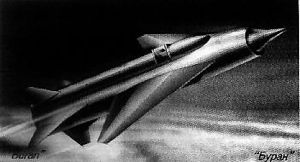
Home - Search - Browse - Alphabetic Index: 0- 1- 2- 3- 4- 5- 6- 7- 8- 9
A- B- C- D- E- F- G- H- I- J- K- L- M- N- O- P- Q- R- S- T- U- V- W- X- Y- Z
Buran M-44
 Buran missile M-42 and M-44 Buran trisonic ramjet missiles were considered in both manned and unmanned versions. Credit: Khrunichev |
AKA: Buran;M-44;RSS-52. Status: Study 1958. Payload: 1,000 kg (2,200 lb). Thrust: 103.90 kN (23,358 lbf). Gross mass: 50,000 kg (110,000 lb). Specific impulse: 1,500 s.
Manned versions were also considered, but the Soviet leadership refused to allow any further work on the Buran concept.
Following cancellation of the ground-launched version of his RSS-40 Buran missile system, Myasishchev continued to pursue use of the M-42 cruise stage in aviation research and space exploration. In 1958 he appealed to both Khrushchev and Minister of Defense of Malinovskiy to support continued development. He now proposed an unmanned, air-launched version for high speed research.
At this time Myasishchev was developing the first Soviet supersonic bomber, the M-50. On the basis of this immense delta-winged vehicle Myasishchev proposed the RSS-52 aerospace vehicle. The RSS-52 would consist of the M-52 carrier aircraft, derived from the M-50. The M-52 would have an enormous recess in its fuselage, within which would be carried the M-44 ramjet. The M-44, designed by G D Dermichev, would be a derivative of the cancelled M-42. The M-52 would enter a circuit 1,000 km from base, accelerate to supersonic speed, and then launch the M-44. The M-44 would accelerate to hypersonic velocity, conduct a high speed run of an overwater circuit, and then splash down in the sea. A radio beacon would allow location and recovery of the craft.
In the United States, the X-15 was being developed to answer analogous questions. Manned versions of the M-42 had been designed, and Myasishchev was hoping for manned flights of his M-52 as well. However due to the expense and technical problems, Myasishchev was unable to convince the leadership to approve the RSS-52.
Crew Size: 1.
Family: Rocketplane, Suborbital. Country: Russia. Launch Vehicles: Buran RSS-52. Propellants: Air/Kerosene. Agency: Myasishchev bureau. Bibliography: 192, 474.
1954 May 20 - . Launch Vehicle: Buran M, Burya La-350.
- Soviet government decree for full-scale development of trisonic intercontinental cruise missiles. - .
Nation: Russia.
Related Persons: Glushko,
Isayev,
Korolev,
Lavochkin,
Myasishchev.
Program: Navaho.
Spacecraft: Buran M-42,
Buran M-44.
Council of Soviet Ministers (SM) Decree 957-409 'On transfer of intercontinental cruise missile work to the Ministry of Aviation Industry' was issued. Korolev had to place the highest priority on development of the R-7 ICBM. Therefore the final government decree authorised the Lavochkin and Myasishchev aircraft design bureaux to proceed in parallel with full-scale development of trisonic intercontinental cruise missiles. Both missiles would use ramjet engines by Bondaryuk, astronavigation systems by R Chachikyan, inertial navigation systems by G Tolstoysov, and aerodynamics developed by TsAGI (Central Hydrodynamics Institute). Lavochkin's Burya would use rocket booster engines built by Glushko, while Myasishchev's Buran would use Isayev engines. Both missiles were to deliver a nuclear warhead over an 8,500 km range. But the warhead design specified for the Lavochkin missile had a total mass of 2,100 kg, while that for the Myasishchev missile weighed 3,500 kg.
1958 During the Year - . LV Family: Buran M. Launch Vehicle: Buran RSS-52.
- Myasishchev proposed use of the Buran M-42 cruise stage in aviation research - .
Nation: Russia.
Related Persons: Myasishchev.
Spacecraft Bus: Buran M.
Spacecraft: Buran M-44.
On the basis of the immense delta-winged M-50 bomber Myasishchev proposed the RSS-52 aerospace vehicle. The M-50 derivative would enter a circuit 1,000 km from base, accelerate to supersonic speed, and then launch the M-44. The M-44 would accelerate to hypersonic velocity, conduct a high speed run of an overwater circuit, and then splash down in the sea. In the United States, the X-15 was being developed to answer analogous questions. However due to the expense and technical problems, Myasishchev was unable to convince the leadership to approve the RSS-52.
Back to top of page
Home - Search - Browse - Alphabetic Index: 0- 1- 2- 3- 4- 5- 6- 7- 8- 9
A- B- C- D- E- F- G- H- I- J- K- L- M- N- O- P- Q- R- S- T- U- V- W- X- Y- Z
© 1997-2019 Mark Wade - Contact
© / Conditions for Use